Ellen and Jim Have a Blog, Too
We are two part-time academics. Ellen teaches in the English department and Jim in the IT program at George Mason University.


_Pallisers_: 3:6: The story horizon is reconfigured · 6 January 08
Dear Harriet,
As I wrote the day after Christmas, Pallisers 3:6 is transitional & presents problems for a close reader trained to analyze a work in terms of consistent overarching criteria with polished structure which has a beginning, middle, and end (even when the structure is a multiplot design the respected works are finished, have definite climaxes, denouements, and closure). In major ways Pallisers 3:6 manifests the distinctive aesthetic features of long-running soap operas which manifest a feminine aesthetic and are cyclical.
Specifically, Pallisers 3:6 takes us through into two open-ended evolving closures. (The oxymoron comes from uniting a masculine term with a feminine aesthetic.) One of the four long novels which carry the major characters and themes of across the 26 films, comes to a muted close in which basic conflicts are not resolved, but put on hold upon the birth of an heir: let’s call this “the Lady Glencora and Plantagenet Palliser matter” (enacted by the series major stars, Susan Hampshire and Philip Latham).
In addition, the first of the three subsidary shorter novels is set adrift: the two major players of “this Alice and George Vavasour matter” (enacted by the secondary stars of the first six episodes, Caroline Mortimer and Gary Watson) make choices (marriage for the woman, departure for the man), and will be seen on screen no more. But all but those characters who have not died remain in the potential imagined large community of interrelated characters, which make up the film’s universe, and are available to be mentioned again and behavior imputed to them off-screen. Late in the series John Grey (played Bernard Brown, probably long since gone to act elsewhere), is said to have been holding the seat for Silverbridge and now only too happy to vacate the Palliser seat for the now grown-up heir Lord Silverbridge (Anthony Andrews, a secondary star and major player in the concluding parts of the fourth novel) so he, Grey, can work for the public good elsewhere.
But by contrast (or on the other hand), Pallisers 3:6 also begins the second very long running novel of the series. “The Phineas Finn matter” (Phineas played by a third major star and second hero of the series, Donal McCann) is set on foot in the first scene of this part. This novel emerges gradually to take over the part in the scenes which occur in a return to the Arcadian gardens at Matching Priory (which open the first novel in 1:1), with a set of pictorial set-pieces, the first striking one with the heroine who will become Phineas’s loving and politically astute wife, Madame Max Goesler (a fourth major star and second heroine of the series).
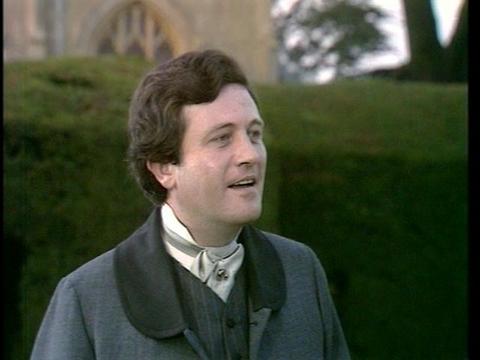
Phineas Finn (Donal McCann) as first glimpsed by Madame Max Goesler
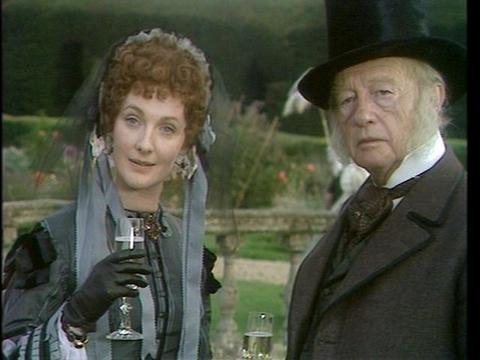
Madame Max Goesler (Barbara Murray) with the Duke of Omnium (Roland Culver) as first seen close up by Phineas Finn
The Phineas matter will be put on hold or deferred at 6:13 (when Phineas having impregnated Mary Floyd Jones [Maire Ni Ghrainne] and voted for Irish Tenant Rights loses his seat) to be replaced by a third much shorter yet central novel, the Lizzie Eustace and Lord Fawn matter (enacted by Sarah Badel and Derek Jacobi, counterparts to Caroline Mortimer and Gary Watson or Anthony Andrews in their place and function as actors). Lizzie Eustace is first encountered at 6:11 and she and Fawn move out of sight in 7:14, she to Scotland, he humiliated out of the public eye. The Phineas matter will not come to its open-ended conclusion until it resumes at 7:14 (the death of Mary and her baby in childbed and return of Phineas to London) and ends at the conclusion of the trial of Phineas for murdering a rival politician, Mr Bonteen (Peter Sallis) for advancement (9:19) when Phineas is exonerated (by Madame Max).
The mood and outlook of the Phineas Finn matter is strongly at variance with the long and shorter novel (i.e., the Pallisers and Vavasours, 1:1-3:6) which has come before: these are radical loss, grief, and failure turned into resignation and compromise, behind which is a very real continual threat to them all of becoming an outcast. This threat hovers over Lady Glencora and Alice whose alternative fates can be seen in the beggar girl and Jane, as well as Plantagenet Palliser who can be easily disinherited. The threat comes to pass or is made good (inflicted) on the two secondary heroes (George Vavasour and Burgo Fitzgerald, played brilliantly by Barry Justice). The climactic scene of this part is in fact the anguish of Burgo Fitzgerald: we see dramatized the reality that the building of this stable society around married pairs depends on the enactment and erasure from memory of violent and ruthlessly amoral acts.
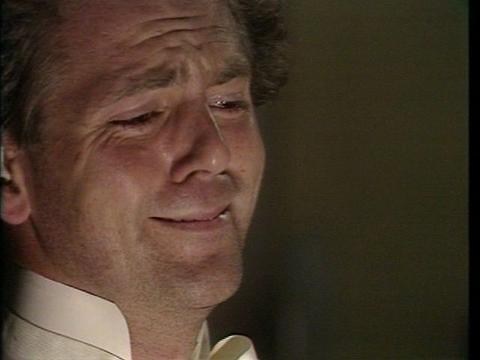
Burgo Fitzgerald (Barry Justice), the last we see of him, deserted, discarded, anguished, shattered
In this case the coerced match of the Pallisers; 2) (off-screen in this 1970s film) Plantangenet Palliser having sex with Lady Glencora, thus cutting off forever from her and Burgo a decent relationship (the virginity taboo is very strong in this series); 3) the fleecing of George Vavasour by Mr Scruby and Mr Grimes as his only way to get a seat in Parliament; and 4) George Vavasour’s ineffectual violence in his attempt to break his grandfather’s will disinheriting him, and to destroy his rival, the unambitious apolitical John Grey. As I’ve written four of the six first episodes end on a close-up of the contorted face of Barry Justice.
The emotionally wrenching scene of Burgo’s despair at having been discarded is, however, assessed against the rising horizon of the new novel where a male outsider (Phineas Finn, propertyless Irish Catholic son of a doctor) and female outsider too (Madame Max, introduced in this part at the beginning of this novel as opposed to Trollope’s Phineas Finn, where she first appears in Chapter 40 as an afterthought, a fourth woman and mature sophisticated mentor for Phineas) will succeed in integrating and becoming central to the lives of the powerful characters in the community.
The outcasts in the Phineas matter are those the viewer is encouraged to despise & see as “other” from him or herself, and scapegoat: Mr Bonteen whose politicking sycophany and competitiveness is done without good grace or manners, showing his far from upper class origins (recalling Mr Bott) and Rev. Joseph Emilius (Anthony Ainley), rejected because he is Jewish, whatever other unpleasant characteristics are given him, like violence towards his wife, which sort of violence is not rejected when George’s breaking Alice’s arm is made a joke of and Lady Glen encourages Grey to “shake” Alice into accepting him. Phineas is from the moment we see him here (and also in Trollope), a socially-upward idealistic-pragmaticist determined to advance himself, a believer in the potentials of parliamentary government to effect good.
The change in horizon causes an immediate change in emphasis in the presentation of Lady Glencora Palliser: at the close of the first scene where on the balcony at Basle she still pretends disinterest in politics, we see this is a facade as when Plantagenet Palliser and Alice leave the balcony to go for a walk together to discuss the election results, Lady Glen grabs the discarded newspaper and reads the news avidly:
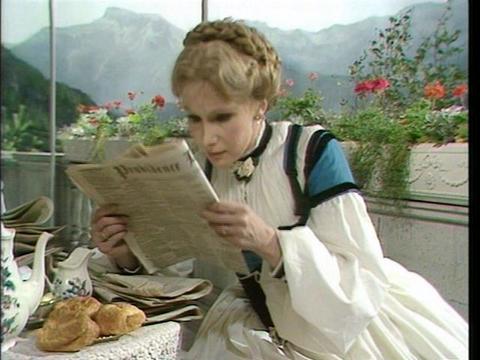
Lady Glencora Palliser (Susan Hampshire) avid for political news
By the end of the episode, she is ecstatic at her pregnancy and new born boy, and after an interlude where she and Palliser attempt to take care of the discarded inconvenient and permanently-damaged Burgo, she is seen complacently networking on behalf of her husband and heir and dismayed by the possibility the Duke may instead of taking Madame Max as his mistress, marry her and himself produce a son who would inherit before her and Plantagenet’s child (for which possibility and their own future titles they have both given up much).
She also reverses herself and instead of rebelling against the norms of her society becomes someone who enforces them—with good humor and ironic wit, but enforces them nonetheless. Palliser himself has renewed hopes of becoming the Chancellor of the Exchequer and their private lives recede as the characters before us are seen to be maneuvring between fulfilling their private lives and public ambitions. For example, in Phineas’s 4th full scene with a woman in 3:6, Lady Laura Kennedy (Anna Massey) we see someone who wants to be Phineas’s political mentor & thus participate in public life, but she is at the same time intensely physically attracted to him. When Phineas kisses Lady Laura’s hand, her eyes show a depth of feeling she can’t quite control.
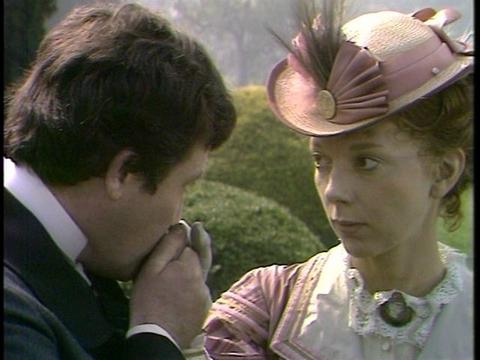
Lady Laura Standish (Anna Massey) her hand kissed by Phineas (Donal McCann), and showing in her face & eyes she’s in love
(Phineas 1st scene is with Mrs Bunce (Brenda Cowling), his 2nd with Lady Glen, & the 3rd with Madame Max.)
Here is a summary of the episodes.
Episode 26: “Finding Alice.” Scene 1) Lady Glen and Alice on the balcony in Switzerland; throughout the scene Lady Glen makes gestures which suggest she is suddenly physically uncomfortable and under distress, is now disposed to scold Alice into accepting John Grey, and Palliser comes with news of pivotal (for the series) outcomes of the election. As unlike Trollope’s CYFH? where George Vavasour does run another time, Raven’s Vavasour cuts his losses and departs upon his grandfather’s disinheriting him, we do not hear that Vavasour has lost but rather a discussion regretting that people like Vavasour try for what they cannot afford (and from Palliser we are back to sympathy for George); we hear of the re-election of Palliser (of course he says), the defeat of Mr Bott (John Stratton now vanishes from the stage), and importantly a new member, Phineas Finn, about whom we are immediately told he is a “nobody” whose money is in as much doubt as George Vavasour’s was.
A parallel is thus set up as Phineas replaces George. Scene 2) Alice and Plantagenet Palliser take their picturesque walk amid the scenery and (a still which repeats an early scene (in 1:1) of Plantagenet courteously, chivalrously helping Griselda, Lady Dumbello walk amid an artificially shaped wood):
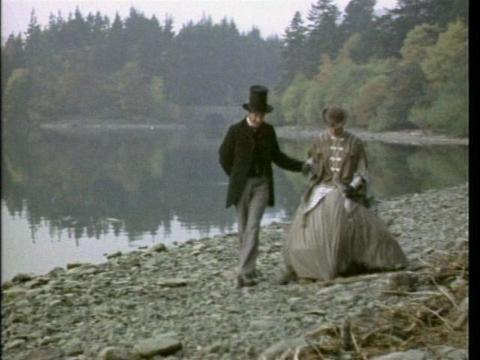
Plantagenet Palliser (Philip Latham) helps Alice Vavasour (Caroline Mortimer) negotiate the rocky terrain by a lake in Switzerland
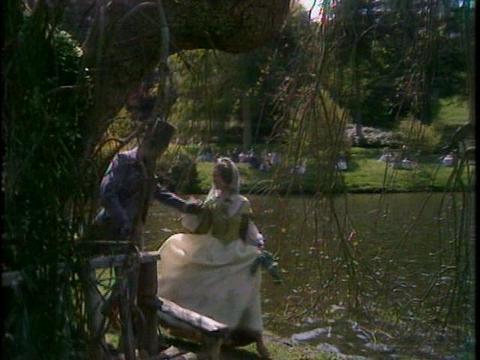
Plantagenet Palliser (Philip Latham) helps Griselda, Lady Dumbello (Rachel Herbert) negotiate the rocky terrain by a lake in a London Park
They glimpse John Grey coming to find Alice, Alice hurries off in a flutter, leaving Grey and Palliser to become congenial friends. Scene 3) Palliser suite in hotel, with Lady Glen fingering her wedding ring, and drinking some concoction; to her the upset Alice, who tells of Grey’s coming, and again Lady Glen is unsympathetic (we are not supposed to ask if she has forgotten all she felt in the earlier parts, all her warnings against marrying without certain love, as the series is shifting into a different key; as Raven’s George Vavasour was suddenly blackened to enact Trollope’s story line ending, so Lady Glen is altered in the way to fit new material; she will have a different relationship to other women from here on in and no longer carry any feminist theme.) Scene 4) Back to lakeside where Grey and Palliser talk; to them Lady Glen, who vows to help Grey win Alice. The tone of the scene is of a comic coda (as are those which follow immediately) as it ends Plantagenet looks surprized and pleased and we look at the lovely still tranquil scenery.
All’s well that ends well? Scene 5) Alice on the balcony and then drawing room in the hotel, pacing, walking, thinking, to her Grey, vexed conversation where she confronts him with the money she owes him and shows considerable resentment; he is presented as weary and agreeing with Lady Glen Alice just needs to be shaked, but he won’t shake her. I can’t resist: gee, thanks mate: no sense that Alice has any case at all in not wanting to marry Grey is presented.
Scene 6) the corridors of power just outside parliamentary chamber. The Duke of St Bungay (Roger Livesey) and Barrington Erle (Moray Watson) are choral figures who discuss who is new, and encounter Laurence Fitzgibbon (Neil Stacey), Irish friend and companion to Phineas, and now we get new important information about Phineas: he “rides well,” is a “good fellow” (by Fitzgibbon’s lights), has “got a clear head and a pleasant manner,” but alas is suspected of “exaggerated views.” Fitzgibbon defends his friend by saying “he worries a bit about the peasants” (for real), but “ain’t got enough tin in his pocket to start shucking his weight around.” Contrast and compare this to Phineas’s earliest [the third] spoken sober line in Trollope’s novel: ”’But I have views of my own,’ said Phineas, blushing again. ‘Of course, you have my dear boy,’ said Barrington, clapping him on the back (Ch 1, p. 50). (This interchange will become part of the first scene where we see Phineas speak and act.)
Episode 27: “Glencora’s News.” Scene 7) back to the balcony in Switzerland, again a reference to George Vavasour with Grey talking in a sharp disparaging manner and Palliser echoing: “a man like George Vavasour … they should not sit in the House of Commons. We need solid men like you.” Grey demurs at public life, Lady Glen appears and on her advice Grey goes off to woo Alice, then a moving scene beautifully acted between the husband and wife when she manages to communicate the news (he is at first absorbed in his newspaper) she is pregnant, e.g.,
Lady Glen: You’re becoming dramatic. No, no, it happens every day.
Palliser: But not to us, my dear …
Delightful comic moments include his tracing an itinerary that would take months, his rushing off to call for doctors which include Trollopian characters from Barsetshire novels (“Dr Thorne, of Silverbridge”), her now for the first time looking fondly at him as child-like; the scene ends with their first kiss on screen, a tender gentle one.
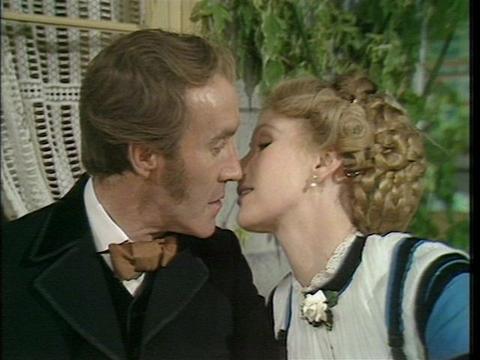
Plantagenet Palliser (Philip Latham) kisses Lady Glencora Palliser (Susan Hampshire) on screen for the first time (she’s pregnant)
Scene 8) a return to gothicism (Lady Glen at Matching Priory grieving over her imprisonment and loss and desire to run away, to die even, was our first). In this one Grey persuades Alice to succumb to him on the grounds life is short and death all around them. “It is getting late” and this is what’s on offer for them for passionate love; it ends in a passionate kiss very like that between Alice and George Vavasour (the first in the series, 2:3, Episode 14, “Lady Glencora’s Illness.”
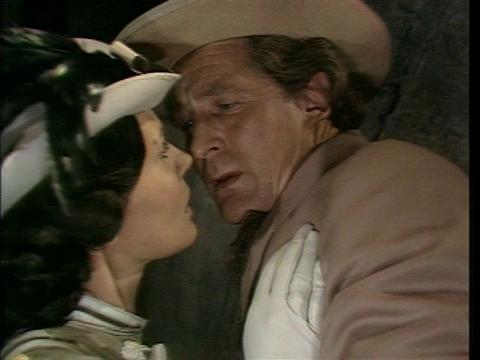
John Grey (Bernard Brown) kisses Alice Vavasour (Caroline Mortimer) passionately in the crypt after she has accepted him
Scene 9) the sitting room of the Duke of Omnium (Roland Culver) who approved of the match engineered by Glencora’s vicious-minded aunts and carried it through by effective threats. They drink to the health of the coming heir. The Duke persists in discounting any concern for Glencora’s health and will not hear that the baby might be a boy. (I think we are supposed to be comically [alas] appalled.) Scene 10) on the balcony in Switzerland after Alice tells that “she is vanquished at last,” Lady Glen confides that she is pregnant. Alice’s feeling she should be a penitent and Lady Glen’s pregnancy used for jokes (mock gestures of cradles, references to Palliser’s overprotective care). Scene 11) Another coda scene in the drawing room off the balcony between Lady Glen & Palliser and Grey and Alice; Palliser invites them to be wed at Matching; Lady Glen is given the Duke’s telegram to read and at long last there is some self-assertion when Lady Glen reads (and Palliser silently acknowledges) the Duke’s unearned unmerited control over them (he wants them to come home immediately), for which distasteful acceptance Palliser must allow Lady Glen to visit the gambling rooms at Baden once again (“Well, you did say, Plantagenet, that I could have whatever I wanted”).
Episode 28: “A Helping Hand.” Scene 12) The gambling room, where Lady Glen and Alice see Burgo betting despairingly and losing all, and Lady Glen goes to Palliser (who has been discussing the way the Grand-duke uses this exploitative place to support his state) to help Burgo as they owe it to him. Scene 13) Burgo’s Lodging room. Perhaps the most moving episode and climactic final key moment in the Lady Glencora and Plantagenet Palliser story. Plantagenet goes to Burgo’s lodgings and we watch the anguished man try to refuse help, cry out, weep; Burgo asks how is it he has “been ordered to go to the devil …”. Scene 13) the Pallisers’ bedroom with Lady Glen again in virgin white, Plantagenet tells Lady Glen he has set up arrangements to supply Burgo with regular money and move him from the gambling town. She is all gratitude at his generosity; the scene is saved by Latham’s part where he acknowledges he has unjustly won and paid off the loser by saying he is Burgo’s “brother.” This is another scene where the two hug tightly at the close. (There are quite a number of these throughout the series, starting with the scene at the breakfast table where she tells him she loves Burgo and does not love him; Pallisers 3:5, Episode 21, “Love Declared.”
Scene 15) Aboard ship, on deck, at night. The two winning couples return home; Palliser has persuaded John Grey to take the seat at Silverbridge; moments of tender affection between Palliser and Lady Glen (and again they kiss), and strong quiet satisfaction between Alice and Grey where she speaks lines which feel Shakespearean about when they will wed, e.g., “when the bands are called thrice, and the feast has been spread, and the guests are all bidden, to watch us wed” (and they kiss, passionately). As with soap operas there is much repetition, but it is to be noted that in each case or different scene where we learn nothing new, the scene itself brings the characters into different contexts and thus represents the same information in terms of other story lines which are thus slowly developed. The new story line here is Grey will go for a seat, and politics can be discussed in the scene (which thus becomes part of the Phineas matter).
Episode 29: “Alice and John.” Scene 16) Lady Midlothian’s spiteful triumphant card is not allowed to change the atmosphere of congratulations as the two couples (Alice & John & a very pregnant Cora & Plantagenet) look over the wedding gifts at Matching Priory; the conversation now brings in new players when Grey now announces he is going to stand for Silverbridge, and Lady Glen says (as if this is just another passtime men happen to have) “Politics. I knew they’d start them again the minute we got home …” We now hear of Mr Mildmay, Mr Monk, and especially Phineas Finn. Thus Lady Glen: “this new young lion from Ireland Mr Phineas Finn, who from the sound of it is seven feet tall and as beautiful as Apollo.” Scene 17) again in the corridors of power outside parliamentary chambers; first Erle and Bungay meet, then Palliser to them, and the talk is of the new Chancellor of the Exchequer (not Palliser) and to them come Phineas Finn and Laurence Fitzgibbon. Finn does not please Bungay; he is ironic when asked how he finds Parliament:
Finn. Oh fascinatin’ Duke. Slightly worrying.
Palliser. Worrying?
Finn. Hmmm. That so many men in the house should be so little representative of those they claim to represent, mmmm?
When he and Fitzgibbon depart, Erle remarks: “Confounded insolence.” A concluding conversation pair between Bungay and Palliser where they discuss Lady Glen’s health, Palliser asserts “she is anxious lest the child be a girl. Oh I have told her of course that any child of hers is equally precious to me, but it is important that we have a son.” Bungay says he must be patient and takes his arm and they walk off discussing when the baby is due.
Scene 18) Matching Priory, midnight, the Duke and Palliser waiting below. We hear nothing above of cries or pain, only finally as Palliser worries away, a child’s cry; the nurse comes down with the baby, and the Duke and then Palliser check the genitals. Perhaps the most distasteful scene for me in all the Palliser series. The Duke will not acknowledge that Glencora is anything more than simply necessary for such an occasion. Scene 19) sheerly church bells ringing to announce this great event. Scene 20) Phineas Finn’s lodgings. A scene where Mrs Bunce (Brenda Cowling) is packing Phineas’s things before his eyes; Fitzgibbon and Mr Bunce (Haydn Jones) come in. The burden of this scene is how Phineas’s clothes are barely adequate. Phineas’s replies are variations on “This will have to do.” We see Mrs Bunce dismiss the political views of Mr Bunce as unimportant, and insinuate all political principles are unreal and irrelevant to real life. Is this a sop to a TV audience? a satire on women or Mrs Bunce? or perhaps what Raven thinks of ideological positions?
Episode 30. “The Christening.” Scene 21) Exterior grounds of Matching Priory, people coming out of the church. Our two couples (John & Alice, carrying the baby, and Plantagent and Lady Glencora, continually coming over to talk to the baby, make eyes at and fondle him; to them important moment of Phineas Finn and Fitzgibbon’s appearance and camera dwells for a moment on Lady Glen lifting her veil and Phineas looking at her.
Lady Glen: “Oh! So you’re Mr Finn (shakes hands). I’ve heard about you. Well, I hope we’ll see your at Matching on some less formal occasion.”
Phineas: “I should be honored, Lady Glencora.”
Lady Glen. Smiles. Holds up veil to show her face to his.
This is a grand musical chair kind of scene like the one that began the series, where we move from one set of characters to another as they move or the camera does. So after Finn leaves, Alice declares him “very charming,” but Lady Glen protests, “Not as charming as my boy”; then Fitzgibbon and Phineas are in another part of the garden as the two men begin to discuss politics, Finn asks why he is invited when he’s a “penniless barrister from Ireland” and Fitzgibbon replies that he supported Mr Palliser and has show himself to be a “brilliant member.” They cross through a high hedge, a liminal kind of moment where we feel we are in another novel at last.
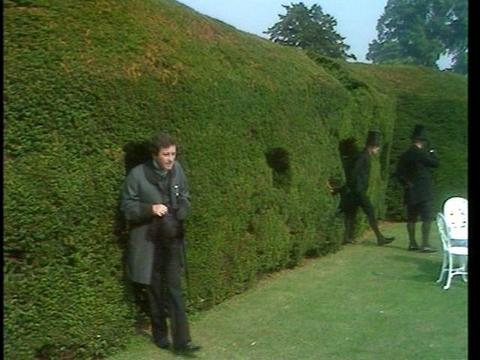
Phineas Finn (Donal McCann) crosses the hedge in Matching Priory Gardens and we are in his novel
A group passes by where we glimpse Lady Laura and she and Phineas exchange glances (this is conventional Hollywood camera technique; you highlight a character suddenly and this tells the viewer we are seeing someone and something important).
Phineas espies Madame Max bowing to the prince with the Duke by her side from afar; the camera then brings us close to the Duke of Omnium and Madame Max and we hear their flirtatious teasing talk. Her talk is calculated to let the Duke know she is not sexually promiscuous but is sophisticatedly aware of sexual pleasure. The Duke says the prince was taken with her, to which she replies, “But not I with his Royal Highness, I fear Duke,” because the “prince presumed:”
Madame Max. His smile was for a merry widow, Duke, and the prince is a married man.
Omnium. Married men may surely flirt. Do you never flirt, Madame Goesler?
Madame Max. Never at christenings, Duke.
Camera back to Fitzgibbon and Phineas watching from afar, and Dolly Longestaffe (Donald Pickering) appears, to make choral comments (as he did in 1:1 with George Vavasour, and then in subsequent appearances, e.g., 1:2, Episode 10, “New Candidate,” with Barrington Erle). We hear that Madame Max is “a Jewish widow from Vienna”; at this her eyes seem to signal them, and Phineas darts off towards her and the Duke, and a tracking shot takes him over to the part of the garden where they are, and in a strong peremptory tone Phineas addresses her, and forces an introduction, then walks off, to leave the older man indignant (and echoing Erle: “Damned insolence”)’; the camera takes us back to Fitzgibbon and Dolly to hear Dolly say “I must say, Finn seems to get on weell, particularly with the ladies.”
Camera now tracks Phineas as he moves to be part of a group of 5: Bungay, Lady Laura, Robert Kennedy (Derek Godfrey), Barrington Erle, and he tells Bungay he and Lady Laura “have met several times.” Back to Dolly and Fitzgibbon. Dolly (chorus like) notes Lady Laura is “ready to eat” Phineas and ask “what is it Laurence about this Phineas Finn?” Dolly moves off and Fitzgibbon goes over to the group of 5, and we hear of the Chancellor’s making mistakes, a possible coming election, Finn attempts to solicit opinions but finds himself offered only enigmatic comments, Kennedy (already in character) says “it would be premature to express” any and Finn is put in his place by references to the tenuousness of his seat in Ireland. Erle: “They do say he [Lord Tulla] wants it [the seat] back for his brother.” Phineas now snubbed by Bungay who takes the others off to discuss what they should agree on about the coming election. Lady Laura and Phineas left, he sulking, and she gently & alternatively reproaching and encouraging him.
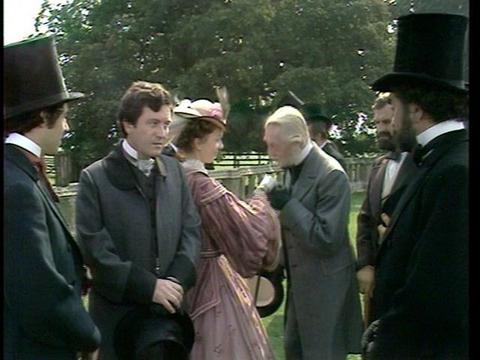
Phineas Finn (Donal McCann) snubbed by the Duke of St Bungay (Roger Livesey) as the others stand by
The camera swings back to the baby and widens out to show us Lady Glen, Alice, Palliser & Grey, and Bungay coming over to them; Bungay talks of the baby and Lady Glen offers (in her new role) a prudential comment (“Wise baby. He knows on which side his bread is buttered”); Bungay takes Palliser off to talk, but not before Palliser urges Lady Glen to go over to the Duke of Omnium, so Lady Glen leaves Alice to take the baby upstairs. Brief conversation pair of Bungay and Palliser if there has to be a general election; then they join Kennedy, Fitzgibbon and Erle and ask them who they trust, a comic silence, camera on goldfish in the lake, and then widens out to locate us by Omnium and Madame Max who are also looking at goldfish in the lake.
Now Lady Glen comes over to Omnium and Madame Max and find herself partly snubbed by Omnium and commanded to keep Phineas Finn away; her teeth clench as she regards the pair and then looks at them from the back (Omnium’s arm is now around Madame Max’s waist). Brief flirtation of Omnium and Madame Max where she looks uncomfortable about what has happened.
Back to Phineas and Lady Laura, continuing the subject of his having to accept he will be treated as a new man, not about to be given an office; someone who must work his way in. Camera over to Bungay, Erle, Palliser, Kennedy, Fitzgibbon and we hear of someone who didn’t stay the course (George Vavasour not named but meant), and Palliser’s servant brings a note, Palliser gives it to the Bungay and we see excitement on Bungay’s face.
Scene 22) Upstairs, Matching, Lady Glen’s room now a baby’s room too, maid there, and goes, and then Alice and Lady Glen watch from window and Lady Glen confides her fears about Madame Max; they look down and see signs of excitement.
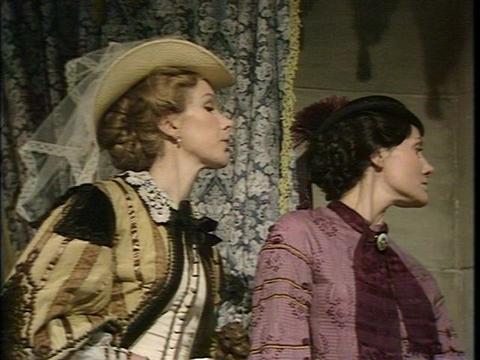
Lady Glencora Palliser (Susan Hampshire) and Alice Vavasour (Caroline Mortimer) watching signs of excitement
The men are gathering:
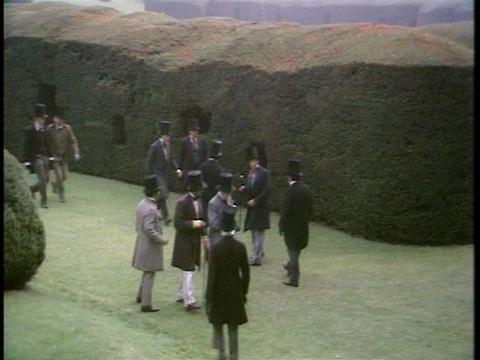
But Phineas off to the side (nervy, determined) tips his hat to Madame Max:
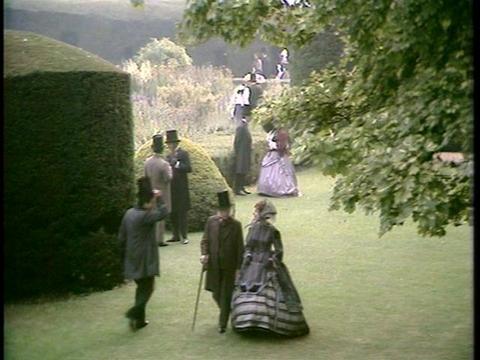
Lady Glencora Palliser (Susan Hampshire) and Alice Vavasour (Caroline Mortimer) watch Phineas Finn (Donal McCann) tip his hat to Madame Max (Barbara Murray) while she is with the Duke of Omnium (Roland Culver)
Palliser rushes, asks Alice to leave (and thus we see her for the last time). We end on a moment of great intensity and the first upbeat close of the series: Palliser’s face aglow with the possibility as change of players may (so Bungay has intimated) pave the way for him to take office as the Chancellor of the Exchequer.
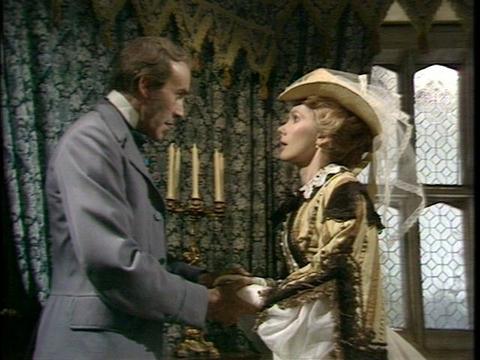
Lady Glencora Palliser (Susan Hampshire) and Plantagenet Palliser (Philip Latham) looking forward to the future with grave hope
Alas, she hangs her head in shame as it seems it was she who was responsible for his almost losing it (this new perspective is all public), but he is too excited to observe this:
Palliser: Cora! Cora! Tis a great thing and it may not be offered again.
And the anamnesic music begins again.
***********
For commentary click on comments.
Sylvia
--
Posted by: Ellen
* * *
Comment
- The sixth episode of the Pallsers divided into two parts: the final denouement and close of the story of the initial phase of the Pallisers’ marriage comes about half-way through. The episode also begins the story of Phineas Finn.
This posting is about the climax of the first sequence: it’s remarkable. I refer to the scene between Plantagenet Palliser (Philip Latham) and Burgo Fitzgerald (Barry Justice) where Justice basically enacts a nervous breakdown in front of us. He is the ultimate victim of what has occurred. He weeps; he shakes; he is alternatively silent because he cannot speak (what has happened is unsayable for him) or he emits bitter words whose truth Palliser doesn’t deny. Palliser is there to pay him for Lady Glencora. Throughout the opening episodes the most powerful, indeed haunting scenes have featured Justice. His meeting the beggar girl in the streets; his standing outside the Palliser mansion are just two. Twice the director and film-maker broke the latest fashion in film-making at that time, which was to avoid voice-over, and in the
first instance the voice-over is Burgo’s as Lady Glen lays in bed remembering what he said to her during their dance. (The second is Lady Glen’s voice as Palliser walks through London remembering her saying she loves Burgo and wants to leave Palliser and live with Burgo.) He is the rabbit at the center of the trap; the sacrifice, the one at the bottom of the heap. It has been a fight between two men where one had all the weapons (Plantagenet).
The scene is utterly improbable. It would never have occurred, and although Trollope has a version of it, he does not have it occur indoors and doesn’t let the characters say explicitly what they do here. His narrator does that. Over and over again these melodramas end on improbable climaxes. We revel in this improbably for in the real world no one in power would let himself be open to possible recriminations or even admit to his power. What’s happening is a castration scene. Burgo is castrated. What I find fascinating is where we are invited to empathize is not with Lady Glen but with the male.
This series conforms closely to the paradigms of melodrama from Stella Dallas (1930s) until today (say Notes on a Scandal or Painted Veil—the latter also disguised as historical-costume drama). What is enacted is a group of characters at the mercy of ruthless social conventions. We see traced an ultimate resignation of the principles to the demands of the powerful in their social and family systems. Three characters stand on stage and expose our deepest emotions to us: they say the usually unspeakable through polarized words and graphic gestures.
I think it may be said this film does covertly (or not so covertly) enact a devastating critique of the ideology it seems to support How? Not just through the obvious contradictions (many of these seen in Lady Glen), but the many freighted scenes where we see the cost and pain of the sacrifices. Burgo in particular is pushed to point of choking; it’s hard for him to let the words come through. It’s done by making him hysterical; he is caught up in hysteria, and thus (in Raven’s terms) a feminized male. It was interesting that Grey’s domination of Alice occurs in tombs. The explicit idea is she has only two choices in life apparently: Grey or death, but the surrounding of this pair (dressed in greys as throughout the production has been greys and blacks) in the gothic stillness of tombs can have the contradictory inference.
The symbolic value of the penis is even made explicit. When < Glencora’s baby is born Omnium rushes over and pulls the blanket away and stares at the baby’s gentilia. He utters a strong noise of satisfaction. So too does Plantagenet for all his “kind” words to Glencora it didn’t matter if the baby was a girl. Here then we have a new presence which can enact, inflict the castration system.
In a sense Lady Glen is castrated too. She is utterly disarmed by kindness in the service of this order by Plantagenet. I know this episode contains some of the backtracking of Can You Forgive Her?.
As the episode begins she scolds Alice for not wanting to marry. Marriage is wonderful she says; Alice must obey. She is spiteful and says cruel things to Alice—just as she does in the final episodes of Trollope’s books. In the words of this and following scenes the old myths are enacted. Alice is presented as falling in love with Grey because she now knows he was violent. Caroline Mortimer has the final thankless role of practically panting to hear how Grey beat up Vavasour. Whether he thinks this or not Raven has his women enact the idea women long to be punished, are hungry for excitement that is amoral (Lady Glen at the gambling table), and are perverse and child-like (the ending of Episode 5 has Lady Glen pouting, led away like a child). And oh yes they need babies. Give them babies and they are ecstatic. See, says Omnium, that’s all she needed.
Until the pregnancy is announced, we had not seen the slightest kiss between Plantagenet and Lady Glen. Now we get several close-ups, but Lady Glen is not to have strong violence. Latham kisses her tenderly. Tenderness is the note here.
The story is about events did not happen. Lady Glen and Burgo didn’t elope. We look at the landscape George was last seen in. We see the impossibility of words to gain one’s desire or even recognition. No where in the film is Alice’s point of view recognized – it is in the novel. Plantagenet did not break down; he came close but he didn’t. He lost too, but his loss was so far back (Episode 1 is long forgotten and the new character given Griselda shows her a weak instrument of the establishment, and the circumstances would make that love affair necessarily adultery) that we forget. We are to forget how incompatible he and Glencora are personally. (This is part of the series’s enactment of the strictures of the family and private property system). And then he wins again. He is the great winner of the first phase of the films.
He is presented as so noble. What makes this palatable is how cynical everyone but Grey who represents the political story is. He remains the chief hero (as he ends the episode), with Phineas as yet not so very noble, a mick on the make and a lady’s man to boot.
E.M.
— Elinor Jan 6, 4:20pm # - The sixth episode also begins the story of Phineas Finn. He is introduced by having someone point to him as an up and coming young man. This is the way with soap operas: you introduce new material within an episode to create interest for the rest. I suggest in this series doing this also has the effect of making the story seem more seamless than it actually is, and again ripping the filmic material away from the text basis. Throughout these 5 and 1/2 episodes Raven has shown an extraordinary creativity in the invention of scenes: his filmic story is developed from within its own terms; when he needs scenes from the book, he takes them, but generally speaking he doesn’t take many. I’d say this series has less scenes literally taken than most, though as ever he keeps the hingepoints of the original books and most of the major character types (somewhat or wholly changed). He does eliminate Widow Greenow and her entourage, and relies on irony and cynicism in the dialogues surrounding the politics for humor; he replaces her with centralizing the Scoby and Grimes material so that George’s political story is an undercurrent to Plantagenet’s.
I’d like to situate the film in its own time and ours too. I was interested to see that the way the wedding of Alice and Grey was indicated was through the characters drinking champagne and making open wishes for one another’s health and coming comfort. This is the way it’s done in the 1972 Emma; there is no huge wedding in the early Austen adaptations; the first occur in the mid-1990s. In Austen there are no weddings. I wondered if the revival of the big wedding we’ve seen in the last couple of decades may be seen in this absence and then insistent presence. Lady Glen and Plangenet’s ceremony carried much more weight than married: it was a grandiose dynastic thing, and the couple do not look at one another, Lady Glen doesn’t want it and has to be forced into slightly hysterical-automatic talk. I wondered if they were thinking of Princess Diana and Charles. If so, we see the difference between fairy tale( this movie) and reality (what happened to the Diana and Charles, their reality).
Then the bells for the birth of a new phallus (perhaps Raven has some blasphemous humor here).
I think one can shed light on the point of view behind the production by looking at the angle it’s framed at in comparison to the angle the recent The Queen is framed at. In The Queen there is no cynical chorus; the queen is presented as earnest and sincere, and Blair is boy-like, talks in vague generalities about moderning until he’s galvanized into behavior that reinforces the monarchy. A rare sceptical moment is when his wife won’t curtsy to her and that’s seen as petty spite.
I suggest that paradoxically this older production casts more sceptical light on the ruling classes than The Queen. Not just the machinery of who gets in shown to be based on money and bribes, but the motives of people suggested to be base and sheerly for power and intrigue. We have the opposing idealists: first Plantagenet, Grey (who writes serious papers no one but Plantagenet and others like him, derided in this production as “dull,” read) and now Phineas. Phineas is (Fitzgibbon sneers) for the peasants; cares about his Irish constituency, and we’ve had some serious references to money and class. Plantagenet’s idealism is only concretized by his absurd concern (so it’s seen) with the decimal system. Phineas is not vague. But we immediately see he’s left out. Lady Laura (played by Anna Massey—I had forgotten) scolds him for sulking (shades of Lady Glen) because he’s not included; he has to suck up for a while longer. She supports the already clearly neurotic looking Kennedy who has money. She may use the word prudence to justify her relationship with Kennedy, but how this is prudent beyond getting money is beyond me. She will pay a hard lesson for getting money by marrying Kennedy.
There is an insistence that Phineas has no money. He lives with the Bunces. He cannot get up the right wardrobe. Again we have politics trivialized or sneered at because it’s implied Mrs Bunce is the powerhouse in her marriage when Mr Bunce starts to talk class politics. Still there is this opposing text about outsiders.
I suggest this production could get away with this opposition because the establishment was more secure. The angle in place we are looking at politics through is the culture of deference and an assumption England is still Chief of the World. That’s why it’s such a flattering series; and we have here a glimpse of why people continue to read Trollope as an ultimate Tory. We are to assume how important these people are, how powerful. In The Queen we are to assume how powerful the people could be, how somehow they get to influence and even control aspects of the queen’s behavior, and Tony Blair is presented as weak, puppet like. The people in the streets are not going to defer. They are interviewed as resentful, and they are not children.
One more comment on the filmic symbols or codes. As the production opened we were in an enormous garden with many of the major characters in a kind of dance, doing different things. There we first see Lady Glen playing games around a bush with Burgo; there we see Plantagenet in earnest talk with Griselda. We see the two hag women (happily in the film Lady Midlothian does not get to gloat over Alice as she does in the book – it would have grated too strongly perhaps?), Omnium on his throne; we return to the garden when Plantagenet and Lady Glen’s marriage is plotted, and when they are brought together in the wood. About the middle of Episode 6 we find ourselves in this garden again. It’s probably Matching but it doesn’t matter what the label is. It’s a kind of eternal green place and now again new characters are introduced. Madame Max who Dolly says the Duke is not interested in marrying (insinuating an affair); Lady Laura Kennedy photographed repeatedly as next to Phineas. Madame Max is in the grey and black and browns of the production; Lady Laura is given pink. She stands out—like Dolly in soft yellow, and Fitzgibbon (pink ribbon his lapel—interesting).
This is transition. I will be interested to see if the garden returns as we swing into the matter of Eustace Diamonds.
E.M.
— Elinor Jan 6, 4:21pm # - From Nick:
“It is indeed difficult to add to what Ellen has written but I will try to add some thoughts on the politics.
If we consider the world of politics as it is presented by Trollope and by the series I think we see that the series takes one half of the picture. Raven is really very good at portraying the sordidness.
This was seen in George’s election campaign but it is also seen in the portrayal of networking, the lust for power, the lack of any sort of principle. Thus in early episodes we had a brilliant portrayal (in many ways the best thing so far) of the loathsome Bott. In thisepisode we see these men (St Bungay, Earle, FitzGibbon, Kennedy)laughing at principle, addicted to power. Plantagenet and even Finn get drawninto this. It is satirised – there is a wonderful moment in the garden whenthese men (the 4 mentioned and Palliser) consider who is to be the next Prime Minister – all top-hatted they fall silent as they consider theiroptions. Raven is spot-on with all this because, as far as I can tellfrom the biography which Ellen posted, he was familiar with this world, with this type of man, with which his novels have a love/hate relationship.
But in Trollope all this is only one side of the argument. In the first place he respects (too much it might be argued) the ideals which the House of Commons represents (I forget in which book that wonderful paean of praise appears). But much more importantly he presents characters who are genuine and committed idealists; one such is Bunce, another is Monk. Bunce’s ideals are not Trollope’s (one of the instances of the limits of his radicalism) but they are treated as genuine. Both he and Monk function as Finn’s conscience (oh how one wishes that at least one of these characters had been a woman – instead Laura Standish/Kennedy plays the Caroline part). There is a choice and a real choice to be made. There are serious and vital issues at stake. None of this has so far appeared in the adaptation.Bunce is presented as somewhat of a figure of fun, his warning to Phineas a minor moment trivialised by Mrs Bunce and speedily forgotten. Maybe things will change in future episodes but I have my fears.
And this is utterly crucial. Because without the presentation of an alternative the satire becomes hollow and empty. It ends up validating that which it pretends to attack because however corrupt and rotten the system may be there is nothing to put in its place. The battle for Finn’s soul is over before ithas begun. We lose the complexity of Trollope’s writing and thought.
Nick.”
— Elinor Jan 6, 4:22pm # - This is in response to Nick’s posting on Pallisers, Episode 6.
My posting was directed to show how Episode 6 was a transition between the story of Can You Forgive Her? and the story of Phineas Finn; Nick has brought in again how Raven strongly differs from Trollope and what we have lost and gained.
Let me say there is a problem with fidelity of discourse. The historic tendency has been that when writers on film keep up simply comparing most novels and films, you will, especially if the novel is deep and has greatness, they find the film inferior.
Why is this? Perhaps the film is inferior, but we all know the film offers things, insights sheerly through pictures, the novel can’t hope to match. I’m not talking merely about the amount of visual and psychological information, but the way in which the pictures are juxtaposed and the uses of archetypes.
My argument in this posting is the central reason for the way in which films are always beat out by novels is the way in which we discuss films is out of techniques developed from literary criticism. Nick may say this is a ploy or special pleading, and I would agree that words have depths and details pictures can’t reach either, and since I’m a word person, I wouldn’t make films superior.
But I think they can function equally. So I agreed in my previous that Raven’s comparison of Burgo with George is all wrong, and his pairing of them continually in the scenes senseless if we are thinking about themes of power.
But not if we see Burgo as a variant on Lady Glen as the person made to submit to the social order and its ruthless corruption (Plantagenet becomes the innocent here, another person swept along by his uncle, forced to give up the very different Griselda), then the continual ironic pairing works. Trollope has intimations of seeing Burgo this way, but finally he’s not persuaded. Trollope sees Burgo as a free agent who is weak and needs to hang on to a Lady Glen and her money.
Nick mentions how melodramatic the series is, yes. Melodrama is a form we are taught to despise from literary studies which are anti-feminine, anti-woman. But in film studies melodrama is making acomback and especially when it comes to costume drama. Costume is a worthy thing to study as a way of figuring forth meaning:
http://server4.moody.cx/index.php?id=580
Notice, Nick and all, how Nick reached for the top hats as conveying ironic meaning:
Thus in early episodes we had a brilliant portrayal(in many ways the best thing so far) of the loathsome Bott. In this episode we see these men (St Bungay, Earle, FitzGibbon, Kennedy) laughing at principle, addicted to power. Plantagenet and even Finn get drawn into this. It is satirised – there is a wonderful moment in the garden when these men (the 4 mentioned and Palliser) consider who is to be the next Prime Minister – all top-hatted they fall silent as they consider their
options.
Do have a read of the above blog about the importance of costume. Pam Cook’s book, Fashioning the Nation is very readabel and excellent; so too Sarah Kozloff’s Overhearing Film Dialogue and Invisible Storytellers. The weakness of the Palliser series is in its lack of voice-over and insufficient subjective filmic techniques. Dear Nick, that’s the weakness.
I agree the series in comparison to Trollope’s is reactionary instead of liberal (19th century version here) in outlook, but let’s agree that this does not necessarily make it bad art. Both men see the corruption and cost of the system; Trollope wants to change and reform and improve it. He believes in progress. I feel Raven doesn’t. Not only is the battle for Finn’s soul over before it has begun, Raven’s heart is with the male heart-wrenching ravaged figures who litter the landscape (Burgo, and even George) and (not paradoxically) with the idealistic gentleman (is not Plantagenet emerging as our salvation?). Trollope’s Planagenet is too grown up, too ripe by the end of the series to see what he does as anything more than palliations which make him feel better, give him a raison d’etre, do a little good.Phineas a secondary Palliser. Also idealist but about different less socially acceptable things.
Film art is folk art. We are watching a folk fairy tale and so we have to say what can we infer from this opposition of heart-wrenching anguish and neuroticism v holding fast to older ideals. It may be in the year 2007 only a few decent politicians are still working for palliations, and let’s note when they do they are criticized for not trying to attack the beast at its core. In the US this would be things like reversing the power of the dictator-presidency, setting up real social programs, reversing the tax system. The audience may not see this inference of course but it’s the way films try to work in their attempt to reach a mass audience.
Interestingly the pallidness of this Phineas material which I suggested came from having too many superficial or epitomizing dialogues with the women so marginalized as tokens, in this light comes from the figure in the center not being someone Raven cares about particularly. Lots of literary critics have said the weakness of Trollope’s Phineas books is they are not sufficiently internal and Phineas is not interesting.
He is to young black men in the classes I’ve had who want to break in and climb up.
I realize how inadequate my attempt to persuade Nick and others to start thinking about films through filmic art has been in the sense that I’ve been too short and only caught at a few elements: genre,characteristics of film, its folk nature and archetypes, the importance of costume and mise-en-scene.
Ellen
— Elinor Jan 6, 4:27pm #
commenting closed for this article
